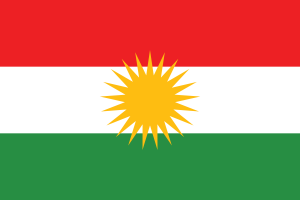Language/Northern-kurdish/Grammar/Demonstrative-Pronouns
| ◀️ Personal Pronouns — Previous Lesson | Next Lesson — Possessive Pronouns ▶️ |
Introduction[edit | edit source]
Welcome to the lesson on Demonstrative Pronouns in Northern Kurdish! Demonstrative pronouns are an essential part of the language as they help us point out specific people, objects, or places. In this lesson, we will explore the various forms and uses of demonstrative pronouns in Northern Kurdish. By the end of this lesson, you will be able to confidently use demonstrative pronouns in your conversations. So let's dive in!
Forms of Demonstrative Pronouns[edit | edit source]
In Northern Kurdish, there are three main forms of demonstrative pronouns: the near demonstrative pronouns, the far demonstrative pronouns, and the neutral demonstrative pronouns. These forms help us indicate the distance between the speaker and the object being referred to. Let's take a closer look at each form and how they are used.
Near Demonstrative Pronouns[edit | edit source]
The near demonstrative pronouns are used to refer to objects that are close to the speaker. They are also used to indicate familiarity or emphasis. In Northern Kurdish, the near demonstrative pronouns are:
| Northern Kurdish | Pronunciation | English Translation |
|---|---|---|
| vê | vay | this |
| vêyî | vay-yi | this one |
| vêyên | vay-yan | these |
For example:
- Ez vê kitêbê dibînim. (I see this book.)
Far Demonstrative Pronouns[edit | edit source]
The far demonstrative pronouns are used to refer to objects that are far from the speaker. They are also used to indicate unfamiliarity or detachment. In Northern Kurdish, the far demonstrative pronouns are:
| Northern Kurdish | Pronunciation | English Translation |
|---|---|---|
| wê | way | that |
| wêyî | way-yi | that one |
| wêyên | way-yan | those |
For example:
- Hûn wê malê dibînin. (You see that house.)
Neutral Demonstrative Pronouns[edit | edit source]
The neutral demonstrative pronouns are used to refer to objects that are neither close to nor far from the speaker. They are also used when the speaker does not want to emphasize or distance themselves from the object being referred to. In Northern Kurdish, the neutral demonstrative pronouns are:
| Northern Kurdish | Pronunciation | English Translation |
|---|---|---|
| ew | ev | that |
| ewyî | ev-yi | that one |
| ewyên | ev-yan | those |
For example:
- Ji bo wî şexsê ew carê min fêm nekir. (For that person, I did not understand this time.)
Usage of Demonstrative Pronouns[edit | edit source]
Demonstrative pronouns can be used in various ways to provide clarity and context in a sentence. Let's explore some common ways in which demonstrative pronouns are used in Northern Kurdish.
Identifying Objects[edit | edit source]
One of the main uses of demonstrative pronouns is to identify and specify objects. For example:
- Ev xwendekar nû ye. (This student is new.)
- Wê pirtûkê ji min re bide. (Give me that book.)
In both sentences, the demonstrative pronouns "ev" and "wê" are used to point out specific objects and provide additional information about them.
Pointing out Locations[edit | edit source]
Demonstrative pronouns can also be used to point out specific locations. For example:
- Di wê bajarê de hewceyên gelek hene. (There are many needs in that city.)
- Vê deverê pir baş e. (This place is very nice.)
Here, the demonstrative pronouns "wê" and "vê" are used to indicate specific places and provide a better understanding of the location being referred to.
Emphasizing or Contrasting[edit | edit source]
Demonstrative pronouns are often used to emphasize or contrast between different objects or situations. For example:
- Vê rûpelê ne ji vê rûpelê xweş e. (This page is not as nice as that page.)
- Wê kesê ev yek ji min re xwendî kir. (That person studied this one for me.)
In these sentences, the demonstrative pronouns "vê" and "wê" are used to create a distinction and highlight the differences between the objects or situations being discussed.
Cultural Insights[edit | edit source]
In Northern Kurdish culture, the usage of demonstrative pronouns can vary depending on the region or dialect. Some regions may have additional forms or variations of demonstrative pronouns that are specific to their dialect. It is interesting to note these regional differences and how they contribute to the richness and diversity of the Northern Kurdish language.
In addition, demonstrative pronouns are often used in storytelling and folklore to create vivid imagery and set the scene for the audience. The choice of demonstrative pronouns can help transport the listeners to specific places or times, making the stories more engaging and captivating.
Practice Exercises[edit | edit source]
Now, let's practice what we have learned! Choose the correct demonstrative pronoun to complete each sentence.
1. ____ kitêb jê re bide. (Give that book to him.) 2. ____ kesên li vir in? (Who are these people?) 3. ____ malê dikirin? (Where were they building that house?) 4. ____ xwendekarên nû ne. (These students are not new.)
Answers: 1. Wê 2. Ev 3. Wê 4. Ev
Conclusion[edit | edit source]
Congratulations! You have successfully learned about demonstrative pronouns in Northern Kurdish. You now have the knowledge and skills to confidently use demonstrative pronouns to identify objects, point out locations, and emphasize or contrast between different situations. Keep practicing and incorporating demonstrative pronouns into your conversations to further enhance your Northern Kurdish language skills. We hope you enjoyed this lesson and found it helpful in your language learning journey!
Other Lessons[edit | edit source]
- Gender
- Plurals
- Nominative Case
- Dative Case
- Roots of Northern Kurdish
- Place Adverbs
- How to Use Be
- Questions
- Alphabet and Pronunciation
- Give your Opinion
Template:Northern-kurdish-Page-Bottom
| ◀️ Personal Pronouns — Previous Lesson | Next Lesson — Possessive Pronouns ▶️ |

